There are 11 native species of turtles in Rhode Island, consisting of seven inland species and four types of Sea turtles that have been spotted off the coast. Many of Rhode Island’s native turtles are state-protected, such as the Northern Diamondback terrapin and the Wood turtle.
The turtle species that are native to Rhode Island can be owned as pets, but cannot actually be sold within the state. This means that these turtles have to be imported from other areas. To remove turtles from the wild in Rhode Island (which we do not recommend) is only legal with the correct permit.
If you are hoping to get one of Rhode Island’s native species as your next pet, we encourage you to check local animal shelters first in case they have any that are up for adoption. If this isn’t possible, then always buy captive-bred specimens from registered breeders and obey all state laws.
Feel free to use this list as either a field herping guide while out on the trail in Rhode Island or as a primer for figuring out your next pet turtle.
Here are the 11 native species of turtles in Rhode Island.
Turtles in Rhode Island
1. Eastern Box Turtle
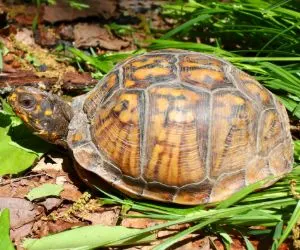
- Experience Level: Beginner
- Family: Emydidae
- Scientific Name: Terrapene carolina carolina
- Other Names: Common Box turtle, Land turtle
- Adult Size: 4 to 7 inches (10 to 18 cm)
- Lifespan: Up to 40 years
- Average Price Range: $120 to $400
Eastern Box turtles are a protected species in Rhode Island and are more terrestrial than most other turtles. They can be encountered in grasslands and woodlands and generally remain within the same small range throughout their lives. They need a water source such as a pond in their habitat as well.
Eastern Box turtles are a striking species with highly-domed dark brown shells and distinctive yellow and orange stripe or dot markings. Their plastrons are also dark brown and their brown skin is covered with more orange markings. Males have concave plastrons while the plastrons of females are flat.
These land-dwelling turtles eat an omnivorous diet of small fish, insects, fruits, and vegetation. They can travel up to 50 meters in one day while foraging.
2. Northern Diamondback Terrapin

- Experience Level: Beginner to Intermediate
- Family: Emydidae
- Scientific Name: Malaclemys terrapin terrapin
- Other Names: Diamond-backed terrapin
- Adult Size: 4.5 to 9 inches (11.5 to 23 cm)
- Lifespan: 25 to 40 years
- Average Price Range: $250 to $300
Northern Diamondback terrapins are an aquatic species that prefer brackish waters where the sea meets tidal estuaries. They also inhabit coastal marshlands and can often be spotted swimming along with their heads poking out like periscopes. This is another of Rhode Island’s protected species.
Northern Diamondback terrapins have black to brown to gray wedge-shaped shells, often with additional yellow coloring. On each scute, they have dark ring-like markings around the edges and a series of central ridges running down the keel of their shells.
Diamondback terrapins feed on crustaceans, mollusks, and other invertebrates as well as shellfish such as clams or winkles. They will also occasionally eat vegetation for some nutrients.
3. Eastern Musk Turtle

- Experience Level: Intermediate
- Family: Kinosternidae
- Scientific Name: Sternotherus odoratus
- Other Names: Common Musk turtle, Stinkpot
- Adult Size: 4 to 5 inches (10 to 12.5 cm)
- Lifespan: 50+ years
- Average Price Range: $20 to $90
Eastern Musk turtles are a small aquatic species that inhabit clear, slow-moving waters with plenty of aquatic vegetation for cover. They are also affectionately known as “Stinkpots” because of the powerful musk that they can release if they feel under threat.
Eastern Musk turtles have black to dark brown to gray-green shells that don’t sport any bright markings. Their heads are also dark with two yellowish stripes running down their long necks and they have fleshy barbels on their chins and throats.
Eastern Musk turtles aren’t brilliant swimmers and will often walk along the bottom of the pond or lake where they live. They are nocturnal omnivorous that hunt small amphibians, crustaceans such as shrimp, and mollusks from the cover of aquatic vegetation. They will also eat plants occasionally.
4. Eastern Painted Turtle
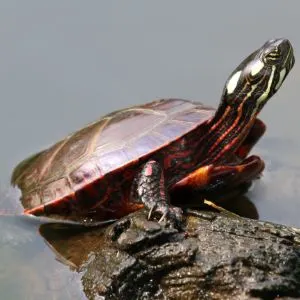
- Experience Level: Beginner
- Family: Emydidae
- Scientific Name: Chrysemys picta
- Other Names: N/A
- Adult Size: 4 to 10 inches (10 to 25.5 cm)
- Lifespan: 30 to 50 years
- Average Price Range: $20 to $50
Eastern Painted turtles are one of Rhode Island’s most common species. These medium-sized aquatic turtles are the state’s second-largest freshwater species and prefer shallow waters and wetlands such as marshes and ponds and slow-moving rivers.
Eastern Painted turtles are distinct from the other subspecies because their scutes are organized into neat parallel lines at the back and pale-colored front edges. The shells are typically black to dark brown or dark green with edging colors such as yellow or red. Their plastrons are yellowish and they also have yellow stripes running down their faces and necks.
These aquatic turtles are diurnal and usually stay close to the water. They bask frequently on logs or rocks jutting out of the water. They will hunt small amphibians, insects, and mollusks as part of an omnivorous diet. They will also eat vegetation occasionally.
5. Common Snapping Turtle

- Experience Level: Intermediate to Expert
- Family: Chelydridae
- Scientific Name: Chelydra serpentina
- Other Names: Common Snapper, Eastern Snapping turtle, Snapper
- Adult Size: 8 to 20 inches (20 to 51 cm)
- Lifespan: 30 to 50 years
- Average Price Range: $20 to $40
Common Snapping turtles are Rhode Island’s largest freshwater turtles. These aquatic juggernauts look like something straight from the Jurassic period, with powerful beaks, potent claws, and long tails covered with saw-toothed spines. Their thick shells range from dark brown to green.
These powerful turtles quickly become one of the top predators in their aquatic habitats. They inhabit most bodies of water across the state but prefer larger sources like lakes, ponds, and reservoirs. They can bite through most things with relative ease and hunt among the dense aquatic vegetation.
Common Snappers will eat whatever they can catch. This usually means amphibians, fish, insects, and smaller turtles. They have also been known to catch and eat waterfowl and will also consume aquatic vegetation now and then.
6. Spotted Turtle
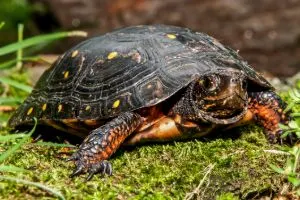
- Experience Level: Intermediate to Expert
- Family: Emydidae
- Scientific Name: Clemmys guttata
- Other Names: N/A
- Adult Size: 4 to 5 inches (10 to 12.5 cm)
- Lifespan: 25 to 50 years
- Average Price Range: $75 to $100
This small, beautiful species is sadly labeled as a Species of Greatest Conservational Need in Rhode Island due to habitat loss and environmental sensitivity. Spotted turtles inhabit boggy or wetland habitats with plenty of vegetation.
Spotted turtles have black to dark brown shells that are covered with their vibrant eponymous yellow spots. Their plastrons are also yellow and have large black patches on either side. The size of these blotches varies between individuals.
Spotted turtles are omnivores and usually consume crustaceans, insects, and mollusks along with vegetation.
7. Wood Turtle

- Experience Level: Intermediate
- Family: Emydidae
- Scientific Name: Glyptemys insculpta
- Other Names: N/A
- Adult Size: 5.5 to 8 inches (14 to 20 cm)
- Lifespan: 40 to 60 years
- Average Price Range: $250 to $500
Wood turtles are another threatened species native to Rhode Island. They are classed as a Species of Greatest Conservational Need and are rarely seen in the wild. When they are encountered, they can be found in woodland habitats with water sources such as still ponds.
Wood turtles get their name from their beautiful shells, which look as if they’ve been sculpted from wood. The texture is rough, like wood grain, as are some of the patterns present on the carapace. Wood turtles are mostly brown all over.
These turtles are mainly terrestrial and forage for food throughout the day. They are omnivorous and mainly eat berries and plants along with insects and mollusks such as earthworms. They often drum their hind feet on the ground to trick worms into thinking it’s raining.
Along with these seven native freshwater species, Rhode Island also sees four species of Sea turtles grace the coastline. It is illegal to own any of these species as they’re federally protected and many are classed as endangered. We’ve listed these turtles below along with some of the main facts. Visit the links provided for more information.
8. Green Sea Turtle
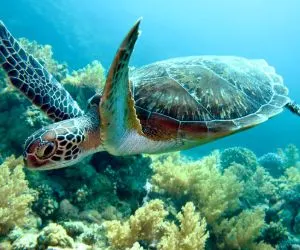
- Family: Cheloniidae
- Scientific Name: Chelonia mydas
- Other Names: N/A
- Adult Size: 3 to 4 feet (90 to 120 cm)
- Weight: 300 to 400 lbs (135 to 180 kg)
- Lifespan: 80 to 100 years
- Conservation Status: Endangered
- Habitat: Bays and shores along coastlines and open ocean waters, seen during summer months
- Clutch Size: Around 110 to 115 eggs, with 2 to 5 clutches per breeding season
- Food: Mostly herbivores, eating algae, sea grasses, and seaweed
- Appearance: Smooth green to brown shells shaped like hearts, edged in yellow. Cream-colored scaly skin with shades of green
Head to our Green Sea turtle page for more information.
9. Kemp’s Ridley Sea Turtle

- Family: Cheloniidae
- Scientific Name: Lepidochelys kempii
- Other Names: Atlantic Ridley Sea turtle
- Adult Size: Around 25 inches (63.5 cm)
- Weight: 75 to 100 lbs (34 to 45 kg)
- Lifespan: Around 30 years
- Conservation Status: Critically Endangered
- Habitat: Sandy or muddy coastlines with shallow waters
- Clutch Size: Between 100 and 110 eggs, 2 to 3 clutches per breeding season
- Food: Crustaceans, shellfish
- Appearance: Slightly hooked beaks, triangle-shaped heads. Green to gray round shells. Muted cream or yellow plastrons and undersides.
Visit our Kemp’s Ridley Sea turtle page for more information.
10. Leatherback Turtle

- Family: Dermochelyidea
- Scientific Name: Dermochelys coriacea
- Other Names: N/A
- Adult Size: 6 to 7 feet (182 to 213 cm)
- Weight: 1200 to 1450 lbs (545 to 658 kg)
- Lifespan: Around 30 years
- Conservation Status: Vulnerable
- Habitat: Warm waters, mainly shallow, calm bays or lagoons. Nests common on sandy beaches.
- Clutch Size: Between 100 and 110 eggs
- Food: Jellyfish is the staple of their diet, but they will also eat other sea creatures
- Appearance: Their large carapaces are soft, unique among sea turtles, with prominent ridges. Colors vary between black and dark gray.
For more information, see our Leatherback Sea turtle page.
11. Loggerhead Sea Turtle
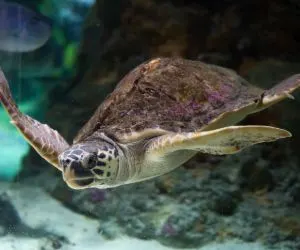
- Family: Cheloniidae
- Scientific Name: Caretta caretta
- Other Names: N/A
- Adult Size: 30 to 45 inches (76 to 114 cm)
- Weight: Approximately 155 pounds (70 kg)
- Lifespan: 70 to 80 years
- Conservation Status: Endangered
- Habitat: Coastal regions, mainly shallow bays. Prefer sub-tropical waters. Sandy ocean beaches for nesting
- Clutch Size: Between 100 and 125 eggs, 4 to 5 clutches per breeding season
- Food: Carnivorous, mainly eating shellfish, mollusks, and crustaceans
- Appearance: Largest hard-shelled turtles with a reddish-brown carapace and large heads. Undersides are cream to yellowish. Long powerful flippers
Check out our Loggerhead Sea turtle page for more information.
Frequently Asked Questions about Rhode Island turtles
What turtles live in Rhode Island?
Rhode Island is home to 11 species of native turtles. Seven of these species are freshwater turtles and include the Eastern Box turtle, Northern Diamondback terrapin, and Common Snapping turtle. Some of these species, such as Spotted turtles and Wood turtles, are protected in Rhode Island.
Rhode Island’s coasts also play host to four species of Endangered Sea turtles; Green Sea turtles, Kemp’s Ridley Sea turtles, Leatherback Sea turtles, and Loggerhead Sea turtles.
Is it illegal to own a turtle in Rhode Island?
It is not illegal to own virtually any pet turtle in Rhode Island as long as you have the correct permit if required. For most non-protected species, permits are not necessary. However, some laws must be followed.
It is illegal to buy and sell native species within the state of Rhode Island itself. This means that to obtain any of the species detailed in the list above, you must have the relevant permit and import the turtle from another state.
While you can legally take turtles from the wild in Rhode Island with the right permit, we don’t recommend this because it harms local populations.
It is also completely illegal to buy, sell, or possess any Red-eared Sliders in Rhode Island as they can quickly become an invasive species.
Are there Snapping turtles in Rhode Island?
Common Snapping turtles are native to Rhode Island and are the largest freshwater species in the state. They can be found in larger bodies of water such as lakes and ponds. Snappers can be taken from the wild without a permit as long as their shells are more than 12 inches long.
Can you own an Eastern Painted turtle in Rhode Island?
You can own an Eastern Painted turtle in Rhode Island. However, as this is a native species, you cannot buy it directly within the state. Instead, the specimen must be either imported or caught from the wild with the relevant permit.
We do not recommend taking turtles from the wild as it harms local populations and they will not live as long or as comfortably as captive-bred specimens.
Conclusion
Well that brings us to the end of our list of Rhode Island’s native turtles. We’ve covered 11 species on this list – seven freshwater turtles found throughout the state and four Sea turtles that can be seen from the coast.
Whether you use this list as a field herping guide or as a research document to decide on your next pet turtle, we hope you enjoyed it. If planning on getting one of these turtles as a pet, please keep in mind that native specimens cannot be bought or sold in Rhode Island itself. You must import them from elsewhere.
If you enjoyed this list, feel free to comment down below and discuss Rhode Island’s turtles with us!
Other nearby states
